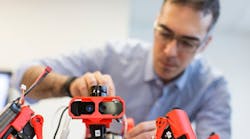Even though you can now fabricate objects out of anything from precious metals to biomaterials with 3D printers, the size of the machine’s build space remains a huge limiter on creativity and engineering prowess remains.
One tactic is to scale up. Cincinnati Incorporated’s Big Area Additive Manufacturing (BAAM) machine is so big (up to 240 x90 x72 in.) it can print a Shelby Cobra. That is dwarfed by the Italy-based company WASP (World’s Advanced Saving Project), which designed has the world’s largest printer.The BigDelta, a towering 12-meter structure that uses local materials, such as clay, to build sustainable habitats, much like those annoying wasps in your garage do.The biomimicry approach is a stroke of genius, but if you’re looking for the best 3D printing architects in the animal kingdom, it’s not a giant wasp. It’s the spider.
Siemens researchers in Princeton, New Jersey, have developed 8-legged 3D printing robots, called SiSpis, capable of extruding polylactic acid (PLA), a mixture of cornstarch and sugarcane used in some 3D printing applications. It makes perfect sense, as arachnids have been 3D printing for millions of years.
New Equipment Digest is an IndustryWeek companion site within Penton's Manufacturing & Supply Chain Group.



